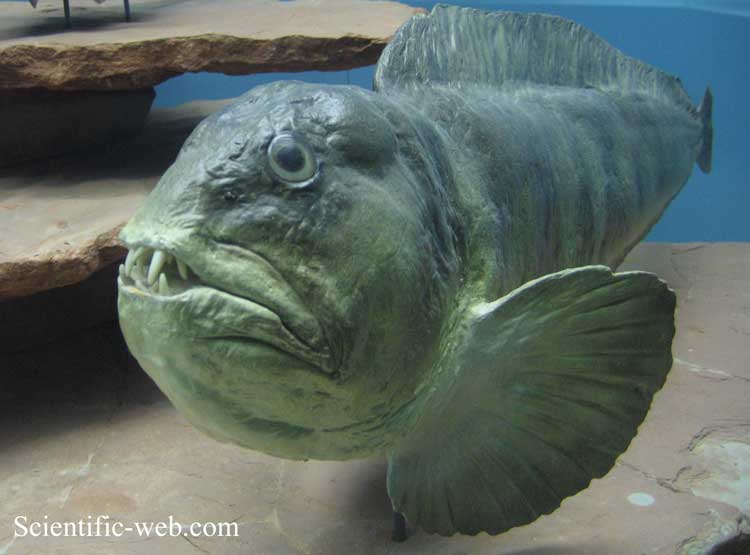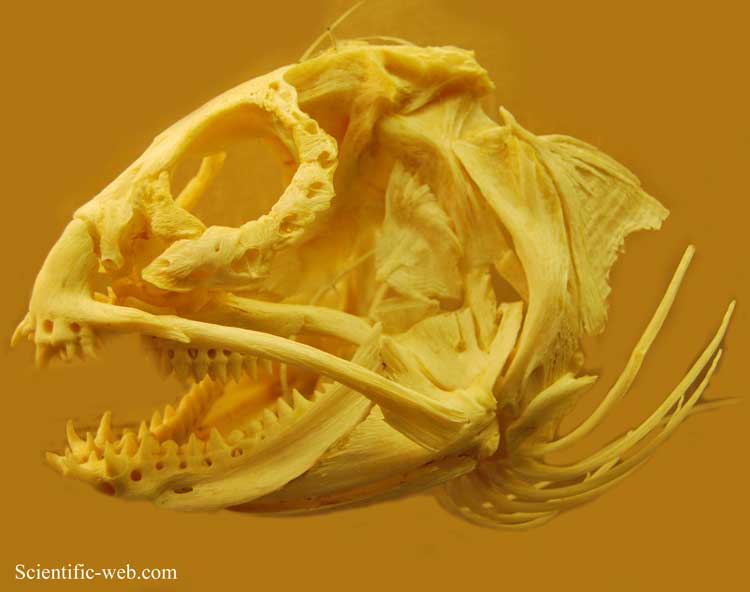
Anarhichas lupus , Atlantic wolffish, Seawolf, Atlantic catfish, wolf eel, Photo: Michael Lahanas
Superregnum: Eukaryota
Cladus: Unikonta
Cladus: Opisthokonta
Cladus: Holozoa
Regnum: Animalia
Subregnum: Eumetazoa
Cladus: Bilateria
Cladus: Nephrozoa
Superphylum: Deuterostomia
Phylum: Chordata
Subphylum: Vertebrata
Infraphylum: Gnathostomata
Megaclassis: Osteichthyes
Superclassis/Classis: Actinopterygii
Classis/Subclassis: Actinopteri
Subclassis/Infraclassis: Neopterygii
Infraclassis: Teleostei
Megacohors: Osteoglossocephalai
Supercohors: Clupeocephala
Cohors: Euteleosteomorpha
Subcohors: Neoteleostei
Infracohors: Eurypterygia
Sectio: Ctenosquamata
Subsectio: Acanthomorphata
Divisio/Superordo: Acanthopterygii
Subdivisio: Percomorphaceae
Series: Eupercaria
Ordo: Perciformes
Subordo: Cottoidei
Infraordo: Zoarcales
Familia: Anarhichadidae
Genus: Anarhichas
Species: Anarhichas lupus
Name
Anarhichas lupus Linnaeus, 1758

Anarhichas lupus, Photo: Michael Lahanas
References
Linnaeus, C. 1758. Systema Naturae per regna tria naturæ, secundum classes, ordines, genera, species, cum characteribus, differentiis, synonymis, locis, Tomus I. Editio decima, reformata. Holmiæ: impensis direct. Laurentii Salvii. i–ii, 1–824 pp DOI: 10.5962/bhl.title.542: 247. Reference page.
Anarhichas lupus in the World Register of Marine Species
Vernacular names
català: Peix llop
dansk: Havkat
Deutsch: Gestreifter Seewolf
English: Atlantic wolffish
español: Pez lobo
suomi: Merikissa
føroyskt: Steinbítur
français: Poisson-loup
Gaeilge: Cat mara an Atlantaigh
íslenska: Steinbítur
italiano: Pesce lupo
lietuvių: Paprastoji vilkžuvė
Nederlands: Zeewolf
norsk: Gråsteinbit
polski: Zębacz pasiasty
davvisámegiella: Stáinnir
српски / srpski: Морски вук
svenska: Havskatt
The Atlantic wolffish (Anarhichas lupus), also known as the seawolf, Atlantic catfish, ocean catfish, devil fish, wolf eel (the common name for its Pacific relative), woof or sea cat, is a marine fish of the wolffish family Anarhichadidae, native to the North Atlantic Ocean. The numbers of the Atlantic wolffish in US waters are rapidly being depleted, most likely due to overfishing and bycatch, and it is currently a Species of Concern according to the U.S. National Oceanic and Atmospheric Administration's National Marine Fisheries Service.[1]
Apart from their unique appearance wolffish are distinguished by the natural antifreeze they produce to keep their blood moving fluidly in their very cold habitat, involvement by both the male and female in brood bearing, and the large size of their eggs. They are also an important factor in controlling green crab and sea urchin populations, which can become overly disruptive to habitats if left unchecked. Wolffish population success is also an important indicator of the health of other bottom-dweller populations, such as Atlantic cod.[2]
Characteristics
Atlantic wolffish
The Atlantic wolffish has retained the bodily form and general external characteristics of small blennies (Blennioidei). The largest specimen recorded measured 1.5 m (5 ft) long and weighed almost 18 kg (40 lb).[3] Its body is long, subcylindrical in front, compressed in the caudal portion, smooth and slippery, the rudimentary scales being embedded and almost hidden in the skin. Atlantic wolffish vary in color, usually seen as purplish-brown, a dull olive green, or blueish gray.[2] An even dorsal fin extends the whole length of the back, and a similar fin from the vent to the caudal fin, as in blennies. The pectorals are large and rounded and the pelvic fins are entirely absent. Its obtuse, eel-like body type makes the fish swim slowly, undulating from side to side, like an eel.[2]
The Atlantic wolffish's distinguishing feature, from which it gets its common name, is its extensive teeth structure. Its dentition distinguishes the Atlantic wolffish from all the other members of the family Anarhichadidae. Both the lower and upper jaws are armed with four to six fang-like, strong, conical teeth. Behind the conical teeth in the upper jaw, there are three rows of crushing teeth. The central row has four pairs of molars and the outer rows house blunted conical teeth. The lower jaw has two rows of molars behind the primary conical teeth. The wolffish's throat is also scattered with serrated teeth.
Atlantic wolffish inhabit both the west and east coasts of the Atlantic. In the west Atlantic, they are present as far north as the Davis Strait, of the Canadian territory of Nunavut, populating the shores of Greenland, Newfoundland, and Nova Scotia, extending as far south as Cape Cod. Although they are seldom seen south of Cape Cod, there have been sightings in New Jersey. The most dense populations are in Georges Bank, the Gulf of Maine and the Great South Channel.[4] In the eastern Atlantic, they range from Russia's White Sea and Novaya Zemlya, through the Nordic countries and British Isles, to the Bay of Biscay.[5]
Atlantic wolffish are primarily stationary fish, rarely moving from their rocky homes. They are benthic dwellers, living on the hard ocean floor, frequently seen in nooks and small caves. They like cold water, at depths of 20 to 500 m (66–1,640 ft).[5] They are usually found in water temperatures of −1 to 11 °C (30–52 °F). Since they can live in near-freezing waters (salt water only freezes at slightly below 0 °C or 32 °F), to keep their blood moving smoothly, they contain a natural antifreeze.[2]
Three related species (Atlantic, northern and spotted wolffish) occur in the north Atlantic.[5] The northern wolffish has loose gelatinous flesh, but the other species are esteemed as food, both fresh and preserved.[5] They are marketed in Britain as "Scotch halibut" and "Scarborough woof", or, simply "woof" in other areas of the northeast coast, and are a popular ingredient in fish and chips.[6] The oil extracted from the liver is said[by whom?] to be equal in quality to the best cod liver oil.[citation needed]
In Iceland and Norway, the species is called steinbítur/steinbit, which literally translates to "stone biter".
Diet
Skull
Drawing of the jaws of the seawolf from 1911 Encyclopædia Britannica
Atlantic wolffish use their strong jaws to eat hardshell molluscs, crustaceans, and echinoderms. They do not eat other fish. They are known to frequently eat large whelks (Buccinum), cockles (Polynices, Chrysodomus and Sipho), sea clams (Mactra), large hermit crabs, starfish, sea urchins. They are an important predator of sea urchins and green crabs, whose populations escalate rapidly and can negatively affect the health of a marine system.[2]
Reproduction
The manner in which Atlantic wolffish fertilize their eggs distinguishes them from many fish. Instead of the female depositing her eggs in the open ocean for the male fish to fertilize and then continue on his way, they are internally fertilized and the male wolffish stays with the nest and protects the eggs for as long as four months, until the brood is strong enough to gain independence. Their eggs are 5.5–6.0 mm in diameter, (among the largest fish eggs known), yellow tinted and opaque. The eggs are laid on the ocean floor, often in shoal water, sticking together in loose clumps, surrounded by seaweeds and stones. Atlantic wolffish mature relatively late, at age six.[2]
Conservation status
According to data compiled by the National Marine Fisheries Service, since 1983, the landings from U.S. fishing vessels of Atlantic wolffish as bycatch has declined 95%, landing 64.7 metric tons (mt) in 2007.[7] In 1950, when the NMFS started collecting their data, 1,098 mt of Atlantic wolffish were landed, worth $137,008. In 1970, 271.2 mt; the landings peaked in 1983 at 1,207 mt, bringing in $455,291; rapidly depleting again and by 1990 the landings were down to 400 mt, and by 2002, 154 mt. The last available data from the NMFS were in 2007 at 64.7 mt, worth a total of $100,341.[7]
Currently, the Atlantic wolffish is categorized as a Species of Concern under the National Marine Fisheries Service. Species of Concern are those species about which the U.S. National Oceanic and Atmospheric Administration, National Marine Fisheries Service (NMFS) has some concerns regarding status and threats, but for which insufficient information is available to indicate a need to list the species under the U.S. Endangered Species Act (ESA).
On October 1, 2008, the Conservation Law Foundation (CLF), along with Dr. Erica Fuller and Dr. Les Watling, petitioned the US NMFS for the protection of the Atlantic wolffish under the ESA. The petition called for the protection of the Atlantic wolffish and wolffish habitat throughout the US northwest Atlantic waters. It recommended a designation of critical habitat be set up to close off both commercial and recreational fishing in those areas (which would overlap closed areas for various other fishing industries for the benefit of fishermen), the development of catch and release protocols, educational programs for fishermen in the Gulf of Maine area, and possession prohibitions.[8] On January 1, 2009 the NMFS announced a positive 90-day finding that the petition was warranted, which triggered the initiation of a status review which will result in a decision on whether to list the species under the ESA. On November 6, 2009, the NMFS issued a finding that the proposed protections were not warranted.[9]
In 2014, HELCOM classified the Atlantic wolffish population in the Baltic Sea as endangered on the IUCN Red List scale.[10]
References
"Atlantic Wolfish, Species of Concern." NOAA National Marine Fisheries Service. http://www.nmfs.noaa.gov/pr/pdfs/species/atlanticwolffish_detailed.pdf (Reviewed October 8, 2008).
Bigelow, Henry B. and William C. Schroeder. "Fishes of the Gulf of Maine." Fishery Bulletin of the Fish and Wildlife Service. Washington, 1953. v 53; p503-506. http://gma.org/fogm/Anarhichas_lupus.htm
"Atlantic Wolffish, Anarhichas lupus: Species of Concern." NOAA National Marine Fisheries Service (Retrieved October 7, 2008).
Atlanitc Wolffish: Conservation Law Foundation (CLF) Fact Sheet. http://www.clf.org/uploadedF [permanent dead link]
Muus, B., J. G. Nielsen, P. Dahlstrom and B. Nystrom (1999). Sea Fish. p. 211. ISBN 8790787005
"Underwater Photography - Wolf Fish"
NMFS Landings Query Results; http://www.st.nmfs.noaa.gov/pls/webpls/MF_ANNUAL_LANDINGS.RESULTS[permanent dead link]
Conservation Law Foundation, DR. Erica Fuller and Dr. Les Watling. "Petition for a Rule to List the U.S. Population of Atlantic Wolffish (Anarhichas lupus) as an Endangered Species Under the Endangered Species Act." October 1, 2008.http://www.clf.org/
"Archived copy" (PDF). Archived from the original (PDF) on 2010-08-03. Retrieved 2009-11-20.
HELCOM (2013). "HELCOM Red List of Baltic Sea species in danger of becoming extinct" (PDF). Baltic Sea Environmental Proceedings (140): 72. Archived from the original (PDF) on 2014-10-07. Retrieved 2014-07-30.
Footnotes
"Anarhichas lupus". Integrated Taxonomic Information System. Retrieved 19 March 2006.
Froese, Rainer; Pauly, Daniel (eds.) (2005). "Anarhichas lupus" in FishBase. November 2005 version.
Retrieved from "http://en.wikipedia.org/"
All text is available under the terms of the GNU Free Documentation License

